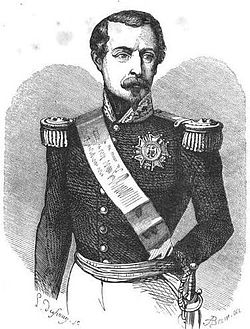Second cabinet of Louis Napoleon | |
|---|---|
Cabinet of France | |
 Louis Napoleon in 1852 | |
| Date formed | 22 January 1852 |
| Date dissolved | 2 December 1852 |
| People and organisations | |
| Head of state | Louis Napoleon |
| Head of government | Louis Napoleon |
| History | |
| Predecessor | First cabinet of Louis Napoleon |
| Successor | Third cabinet of Napoleon III |
The Second cabinet of Louis Napoleon was formed by President Louis-Napoleon Bonaparte on 22 January 1852, replacing the interim First cabinet of Louis Napoleon. It remained in place until the proclamation of the Second French Empire on 2 December 1852, when it was replaced by the Third cabinet of Napoleon III.
| Ministry | From | To | Minister |
|---|---|---|---|
| State | 22 January 1852 | 28 July 1852 | François-Xavier Joseph de Casabianca |
| 28 July 1852 | 2 December 1852 | Achille Fould | |
| Justice | 22 January 1852 | 2 December 1852 | Jacques Pierre Abbatucci |
| Foreign Affairs | 22 January 1852 | 28 July 1852 | Louis Félix Étienne, marquis de Turgot |
| 28 July 1852 | 2 December 1852 | Édouard Drouyn de Lhuys | |
| Interior and Beaux-Arts, Agriculture and Commerce | 22 January 1852 | 25 January 1852 | Victor de Persigny |
| Police | 22 January 1852 | 2 December 1852 | Charlemagne de Maupas |
| Finance | 22 January 1852 | 2 December 1852 | Jean-Martial Bineau |
| War | 22 January 1852 | 2 December 1852 | Jacques Leroy de Saint Arnaud |
| Navy and Colonies | 22 January 1852 | 2 December 1852 | Théodore Ducos |
| Education and Religious affairs | 22 January 1852 | 2 December 1852 | Hippolyte Fortoul |
| Public Works | 22 January 1852 | 28 July 1852 | Noël Lefebvre-Duruflé |
| 28 July 1852 | 2 December 1852 | Pierre Magne |
